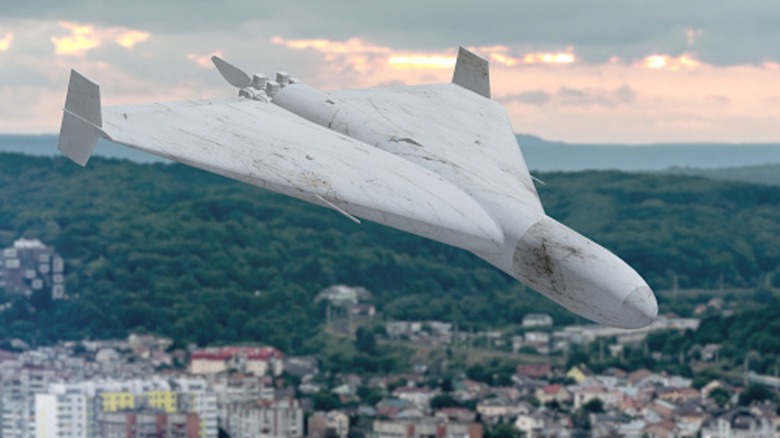Russia Now Has Jet-Powered Attack Drones Immune To Electronic Warfare
Throughout the Russo-Ukrainian War, both sides have used drones to devastating effect. Ukraine, for its part, has found innovative ways of utilizing them, including firing missiles from uncrewed surface vessels (USV) to shoot Russian planes out of the sky. Russia, too, has innovated in a variety of ways, and while it doesn't shy away from firing expensive rockets and missiles into Ukraine, it uses far more drones. They're cheaper, and should they be knocked out by air defense systems, there's always another to take their place.
For much of the conflict, Russia has employed the Iranian-designed Shahed drones. These are loiter attack munitions that fly to an area and smash into their targets, detonating on contact. Essentially, they're high-explosive flying grenades, and Russia has tons of them. The country produces thousands each month and is ramping up production as the conflict continues. Recently, a new type of Shahed drone has entered Ukrainian airspace, posing a significant challenge due to its advanced capabilities.
While most loiter munitions use relatively inexpensive propeller-driven engines to reach their destination, the Shahed-238 (classified as Geran-3 for Russia) is jet-powered. This makes it significantly faster and potentially more maneuverable. Additionally, it comes equipped with electronic warfare (EW) countermeasures, making it more difficult to jam and take it out of the fight. Ukraine's new tactic of flying an old Soviet-era prop plane up to a drone and shooting it won't be as successful against a jet-powered, EW-undermining, deadly drone. Regardless, Ukraine has already produced a potentially effective countermeasure.
Russia's new Geran-3 jet-powered drone
Ukraine has examined the wreckage of several downed Russian drones, including the Geran-3, determining some of its components and capabilities. The Russian site RuAviation has numerous details of the drone outlined, though the veracity of its claims cannot be verified. It describes the uncrewed combat aerial vehicle (UCAV) as an upgrade to the Geran-2, measuring 11.5 feet in length with an 8-foot wingspan. It has a 198-pound high-explosive fragmentation incendiary (HE-FRAG-I) warhead, and a range of 620 miles, capable of operating for up to six hours.
Additionally, some of the Geran-3's warheads have been upgraded to thermobaric, making it capable of taking on more heavily fortified targets. Of particular note is the Geran-3's EW countermeasures, which can recognize areas targeted by satellite signal jamming. Theoretically, it would sense these jamming zones and avoid them, reducing Ukraine's ability to jam the Geran-3's flight operations. The UCAV's turbojet engine allows it to travel at speeds up to 230 mph. Analyzed wreckage of Geran-3s contained nearly 50 foreign-made components from all over the world.
This includes some Western nations, such as the United Kingdom, Germany, Switzerland, and the U.S., although much of the sourcing was from China. Ukraine's countermeasures include a huge arsenal of interceptor drones. These are designed specifically for finding and destroying offensive UCAVs and other drones. Pavlo Palisa, the deputy head of Ukraine's presidential office, said in September 2025, "We have interceptor drones capable of fighting the Shaheds with jet engines. The enemy is developing, and we are not standing still."

